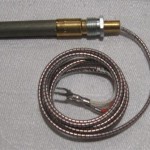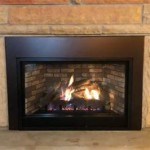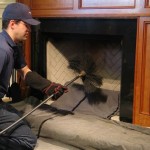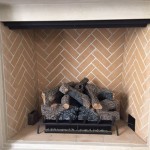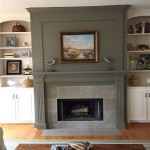Fireplace Brick Ideas: Transforming Your Hearth into a Focal Point
The fireplace often serves as the heart of a home, providing warmth, ambiance, and a natural gathering space. The brick used in and around the fireplace plays a pivotal role in defining its style and overall aesthetic. Exploring diverse fireplace brick ideas can help homeowners create a unique and visually appealing focal point that complements their existing décor and personal preferences. Brick, with its inherent texture, color variations, and durability, offers a wide range of design possibilities.
The choice of brick for a fireplace involves considering several factors, including the size and shape of the fireplace, the architectural style of the room, and the desired level of formality. Different bricklaying patterns, mortar colors, and brick finishes can greatly impact the overall appearance of the fireplace. Furthermore, the selection of brick should be made with an understanding of its thermal properties and its ability to withstand the high temperatures generated by a fire.
Choosing the Right Brick Type
Selecting the appropriate type of brick is crucial for both aesthetic appeal and functional performance. Several options are available, each offering distinct characteristics. Common clay brick, made from clay fired at high temperatures, is a popular choice due to its durability and affordability. It is available in a variety of colors and textures, making it suitable for various design styles.
Firebrick, specifically designed for high-temperature applications, is another important consideration. Firebrick is manufactured to withstand extreme heat without cracking or deteriorating, making it ideal for lining the firebox, where direct contact with flames occurs. Using standard clay brick in the firebox can result in premature failure and potential safety hazards. The installation of firebrick is a critical aspect of fireplace construction and should adhere to established safety standards and building codes.
Reclaimed brick, salvaged from old buildings, offers a unique aesthetic with its weathered appearance and historical character. Reclaimed brick can add a sense of authenticity and charm to a fireplace, but it is essential to ensure that it is structurally sound and free from contaminants before installation. Cleaning and restoring reclaimed brick may be necessary to prepare it for use. Thin brick, a veneer option, allows for the look of brick without the added weight and space requirements. Thin brick is adhered to a substrate, such as concrete board, and is commonly used for refacing existing fireplaces.
Exploring Bricklaying Patterns and Mortar Options
The bricklaying pattern significantly influences the visual impact of the fireplace. The traditional running bond pattern, where bricks are laid in alternating rows with staggered joints, is a classic and versatile choice. Other patterns, such as the stack bond (bricks aligned vertically and horizontally), the herringbone pattern (bricks arranged in a diagonal zigzag), and the Flemish bond (alternating stretchers and headers in each course), offer more distinctive looks.
Mortar color also plays a crucial role in defining the overall appearance of the brickwork. A light-colored mortar can create a bright and airy feel, while a dark-colored mortar can accentuate the individual bricks and highlight their texture. Colored mortars are available in a wide range of hues, allowing homeowners to customize the look of their fireplace to match their desired style. The choice of mortar joint profile, such as concave, V-joint, or flush, further contributes to the aesthetic character of the brickwork. Raked joints, which are recessed, can add depth and shadow, while over-grouted joints create a rustic, textured effect.
The size of the mortar joint should also be considered, as wider joints can create a more rustic or casual look, while narrower joints can provide a more refined and contemporary appearance. Careful attention to detail in the bricklaying process, including ensuring consistent joint widths and proper alignment, is essential for achieving a professional and visually appealing result. The selection of bricklaying patterns and mortar options should be made in conjunction with the overall design aesthetic of the room and the desired level of formality.
Adding Unique Touches with Brick Finishes and Enhancements
Beyond the basic brick and mortar, several options exist to enhance the appearance of a fireplace. Applying a sealant to the brick can protect it from moisture and stains, prolonging its lifespan and preserving its aesthetic appeal. Sealants are available in various finishes, including matte, satin, and gloss, allowing homeowners to customize the level of sheen. Some sealants are specifically formulated to enhance the color of the brick, making it appear richer and more vibrant.
Painting the brick is another option for transforming the look of a fireplace. Painting allows for a complete color change, enabling homeowners to match the fireplace to their existing décor or create a bold statement. When painting brick, it is essential to use a breathable paint that allows moisture to escape, preventing damage to the brick. Applying a primer before painting can help ensure proper adhesion and a uniform finish. Limewashing, a technique that involves applying a thin layer of lime paint to the brick, creates a whitewashed effect that adds a rustic and textured look.
Adding decorative elements, such as brick corbels, archways, or raised hearths, can further enhance the architectural interest of the fireplace. Brick corbels can be used to support a mantel or create a decorative overhang. An archway above the firebox can add a sense of grandeur and sophistication. A raised hearth provides a comfortable seating area and adds visual dimension to the fireplace. These enhancements can be tailored to match the specific architectural style of the room and the homeowner's personal preferences.
The integration of other materials, such as stone, wood, or metal, can also create a unique and visually appealing fireplace design. Combining brick with stone can add texture and visual contrast. Incorporating wood accents, such as a wooden mantel or surround, can create a warm and inviting atmosphere. Metal elements, such as a metal fire screen or decorative accents, can add a touch of modern sophistication. These combinations should be carefully considered to ensure that the materials complement each other and create a cohesive design.

40 Brick Fireplace Ideas Captivating Showstoppers With Timeless Charm Makeover White Wash

30 Gorgeous Painted Brick Fireplace Ideas

35 Gorgeous Natural Brick Fireplace Ideas Part 2 Home Farm House Living Room Design

42 Painted Brick Fireplace Gorgeous Color

27 Brick Fireplace Ideas For Any Design Style Anew

34 Beautiful Fireplace Ideas For Cozy Warmth All Year Long Brick Decor Red Fireplaces Design

Mortar Wash Brick Fireplace Makeover Dimples And Tangles

35 Gorgeous Natural Brick Fireplace Ideas Part 2

27 Brick Fireplace Ideas For Any Design Style Anew

7 Beautiful Ideas For Painting Interior Brick Fireplaces
Related Posts


